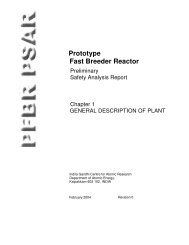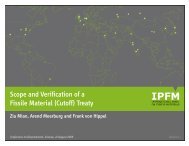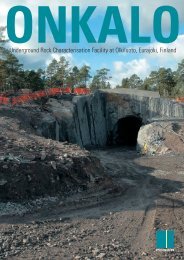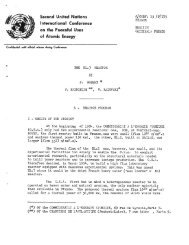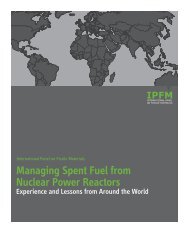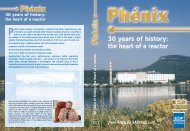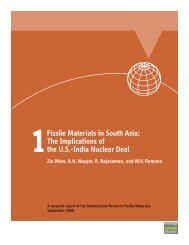Nuclear Proliferation TechnologyTrends Analysis - International ...
Nuclear Proliferation TechnologyTrends Analysis - International ...
Nuclear Proliferation TechnologyTrends Analysis - International ...
Create successful ePaper yourself
Turn your PDF publications into a flip-book with our unique Google optimized e-Paper software.
PNNL -14480<br />
In the second phase (1997-2002), efforts focused on centrifuge construction, assembly,<br />
and mechanical testing. The third phase (since 2002), has involved research, assembly,<br />
installation, and completion of pilot centrifuge cascades.<br />
Iran explored the use of both P1 and P2 centrifuge technology from Pakistan (see section<br />
3.2.3.6). In the mid-1990s, Pakistan supplied about 500 P1 centrifuges to Iran. These<br />
were probably scrapped machines that Pakistan had retired from its main centrifuge<br />
program 52 . By 2003, Iran reported it had 920 P1 centrifuges of which some were<br />
indigenously manufactured or assembled. Iran also received blueprints and information<br />
from Pakistan for constructing P2 machines, but lacked the capability to manufacture<br />
maraging steel rotors, and attempted to make them from carbon composites. This attempt<br />
reportedly failed and the decision was made in 2003 to abandon the P2 approach and<br />
scrap the P2 equipment. 53<br />
Although Iran has reportedly not yet actually enriched any significant quantities of<br />
uranium, it has apparently continued to work to advance its indigenous aluminum<br />
centrifuge technology. It has been reported that Iran may have developed an advanced<br />
supercritical gas centrifuge, with a potential of producing as much as 10 SWU/yr 54 . An<br />
aluminum centrifuge with a throughput of 6 SWU/yr or 7 SWU/yr would be of<br />
supercritical design, connecting two or more segments with a bellows, allowing it to<br />
survive the first critical speed. An aluminum machine with a throughput of 14 SWU/yr<br />
would have three or more segments. This higher throughput would reflect a very<br />
advanced aluminum machine design and a production capability nearly three times that of<br />
first-generation supercritical centrifuges such as the G2 or P2 design 55 .<br />
Iran’s centrifuge development program took over twenty years to produce what is<br />
apparently an indigenous, advanced design for a supercritical aluminum centrifuge based<br />
on early Urenco or Pakistani designs.<br />
3.2.3.11 Libya<br />
In 1995 Libya began to acquire the capability to perform gas centrifuge uranium<br />
enrichment. In 1997, after failing to develop centrifuge technology indigenously, Libya<br />
decided to purchase the technology surreptiously and contacted the international<br />
underground procurement network based in Pakistan that had already supplied Iran<br />
(Section 3.2.3.10) and North Korea (Section 3.2.3.12) with centrifuge components and<br />
designs.<br />
52 Smuggling Of Weapons Of Mass Destruction, David Albright, Capitol Hill Hearing Testimony, Senate Governmental Affairs<br />
Committee, June 23, 2004<br />
53 The spread of nuclear know-how, Peter Grier, Christian Science Monitor, March 2, 2004<br />
54 Iran Has Developed An Advanced Supercritical Aluminum Centrifuge, Nucleonics Week Special Report, Volume 44.Special, March<br />
7. 2003.<br />
55 Estimates of Natanz Centrifuge Power by Iran, IAEA Differed by Factor of Two, Mark Hibbs, <strong>Nuclear</strong> Fuel, Vol. 28, No. 10; Pg. 3,<br />
May 12, 2003<br />
28



